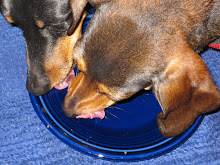Back when I was studying abroad in England, about four years ago now, I found myself eating a vegetable side dish that took me pleasantly by surprise. Long strips of lightly sweet root vegetables fell apart just right between my teeth and on my tongue. I recognized the carrots immediately, but what were the white ones? Were they white carrots? They were a delectable mystery.
I soon found out that these ground dwellers were parsnips. If you've never run across a parsnip before, I am not surprised. They taste like a cross between a carrot and a potato--that's the best comparison I've been able to think up. They look like a white, top-heavy carrot with osteoporosis. They are amazing.
Several times I have tried to recreate the mildly sweet parsnip at home, but each time I somehow failed. Once, I learned the hard way that you should peel parsnips first. Once, I boiled them first which proved fruitless. They just never turned out right.
After several attempts, the dear parsnip faded into the back of my mind to be all but forgotten. Some stroke of fate pulled it to the front last week and I was determined to find the recipe the top all recipes for carrots and parsnips just like that first dish I ate in England. Not only that, but I would serve it at Thanksgiving dinner. So I went to The Food Network and did a search. Chef Danny Boome, a Brit himself, had a simple and mildly sweet recipe for carrots and parsnips calling for olive oil, honey, thyme, salt and pepper. I nearly pissed my pants. It was going to be the one. It was written by an Englishman. It had to be good.
And it was. Even my parents approved. I was all set to buy more ingredients for Thanksgiving until too many people decided they were bringing vegetable dishes to our house for the feast. Oh well, maybe next time! At least my long quest for the perfect parsnip has been satisfied.
**The Vegan Issue**
Honey--it is not vegan. This is another element of my almost veganess. Vegans don't eat honey because it takes bees to create it. Taking honey is like taking bees' food. This is where I get confused. I keep hearing that honey bees are raised and bred to make more honey than necessary so they have enough food and enough to give away. That makes it *okay* to take their honey, but we're also manipulating the bees in some way (is this genetic engineering? just breeding?). Obviously we aren't killing the bees because that would make harvesting honey a fruitless industry. I rarely use it and I don't like the taste of honey itself, so the idea of consuming honey rarely affects me until I come across a recipe like the carrot and parsnip recipe. I am sure the honey can be replaced with agave or brown rice syrup. That is the beauty of having so many sweeteners at your disposal.
In case I don't post beforehand, have a fabulous Thanksgiving!
Subscribe to:
Post Comments (Atom)

No comments:
Post a Comment